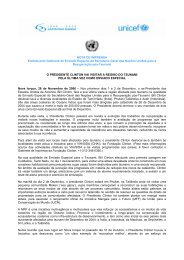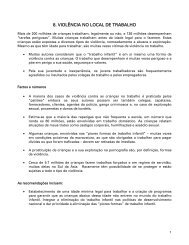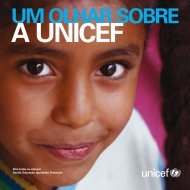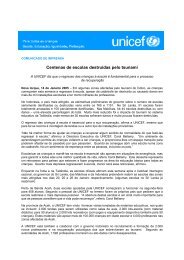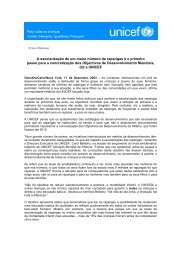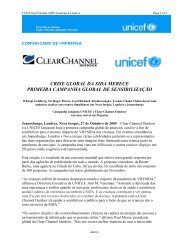Tracking Progress on Child and Maternal Nutrition - Unicef
Tracking Progress on Child and Maternal Nutrition - Unicef
Tracking Progress on Child and Maternal Nutrition - Unicef
You also want an ePaper? Increase the reach of your titles
YUMPU automatically turns print PDFs into web optimized ePapers that Google loves.
In many countries, nutriti<strong>on</strong> has no clear instituti<strong>on</strong>al home;<br />
it is often addressed in part by various ministries or departments,<br />
an arrangement that can hinder effective planning<br />
<strong>and</strong> management of programmes.<br />
In some of the countries with the highest levels of<br />
undernutriti<strong>on</strong>, governments are faced with multiple<br />
challenges – poverty, ec<strong>on</strong>omic crisis, c<strong>on</strong>fl ict, disaster,<br />
inequity – all of them urgent, <strong>and</strong> all of them competing<br />
for attenti<strong>on</strong>. Undernutriti<strong>on</strong> often does not feature prominently<br />
am<strong>on</strong>g these problems, unless it becomes very<br />
severe <strong>and</strong> widespread.<br />
Some leaders may not c<strong>on</strong>sider nutriti<strong>on</strong> to be politically<br />
expedient because it requires investment over the l<strong>on</strong>g<br />
term <strong>and</strong> the results are not always immediately visible.<br />
Furthermore, the interests of d<strong>on</strong>or agencies – with<br />
limited budgetary allocati<strong>on</strong>s for aid in general – are<br />
often focused elsewhere.<br />
In the past, nutriti<strong>on</strong> strategies were not always effective<br />
<strong>and</strong> comprehensive, programmes were insuffi cient in scale<br />
<strong>and</strong> human resources were woefully inadequate, partly due<br />
to insuffi cient coordinati<strong>on</strong> <strong>and</strong> collaborati<strong>on</strong> between<br />
internati<strong>on</strong>al instituti<strong>on</strong>s <strong>and</strong> agencies working in nutriti<strong>on</strong>.<br />
But cost-effective programming strategies <strong>and</strong> interventi<strong>on</strong>s<br />
that can make a signifi cant difference in the health<br />
<strong>and</strong> lives of children <strong>and</strong> women are available today. These<br />
interventi<strong>on</strong>s urgently require scaling up, a task that will<br />
entail the collective planning <strong>and</strong> resources of developing<br />
country governments at all levels <strong>and</strong> of the internati<strong>on</strong>al<br />
development community as a whole.<br />
Undernutriti<strong>on</strong> can be greatly reduced through the delivery<br />
of simple interventi<strong>on</strong>s at key stages of the life cycle – for<br />
the mother, before she becomes pregnant, during pregnancy<br />
<strong>and</strong> while breastfeeding; for the child, in infancy <strong>and</strong><br />
early childhood. Effectively scaled up, these interventi<strong>on</strong>s<br />
will improve maternal nutriti<strong>on</strong>, increase the proporti<strong>on</strong><br />
of infants who are exclusively breastfed up to 6 m<strong>on</strong>ths<br />
of age, improve c<strong>on</strong>tinued breastfeeding rates, enhance<br />
complementary feeding <strong>and</strong> micr<strong>on</strong>utrient intake of<br />
children between 6 <strong>and</strong> 24 m<strong>on</strong>ths old, <strong>and</strong> reduce the<br />
severity of infectious diseases <strong>and</strong> child mortality.<br />
Undernutriti<strong>on</strong> is a violati<strong>on</strong> of child rights. The C<strong>on</strong>venti<strong>on</strong><br />
<strong>on</strong> the Rights of the <strong>Child</strong> emphasizes children’s right to the<br />
highest attainable st<strong>and</strong>ard of health <strong>and</strong> places<br />
12 <str<strong>on</strong>g>Tracking</str<strong>on</strong>g> <str<strong>on</strong>g>Progress</str<strong>on</strong>g> <strong>on</strong> <strong>Child</strong> <strong>and</strong> <strong>Maternal</strong> Nutriti<strong>on</strong><br />
resp<strong>on</strong>sibility <strong>on</strong> the State to combat malnutriti<strong>on</strong>. It also<br />
requires that nutritious food is provided to children <strong>and</strong> that<br />
all segments of society are supported in the use of basic<br />
knowledge of child nutriti<strong>on</strong> (article 24). Nutriti<strong>on</strong> must be<br />
placed high <strong>on</strong> nati<strong>on</strong>al <strong>and</strong> internati<strong>on</strong>al agendas if this<br />
right is to be fulfi lled.<br />
2. THE IMPORTANCE<br />
OF NUTRITION<br />
C<strong>on</strong>sequences of undernutriti<strong>on</strong> <strong>and</strong><br />
the impact of nutriti<strong>on</strong> interventi<strong>on</strong>s<br />
<strong>on</strong> child survival<br />
<strong>Child</strong>ren who are undernourished, not optimally breastfed<br />
or suffering from micr<strong>on</strong>utrient defi ciencies have substantially<br />
lower chances of survival than children who are well<br />
nourished. They are much more likely to suffer from a<br />
serious infecti<strong>on</strong> <strong>and</strong> to die from comm<strong>on</strong> childhood<br />
illnesses such as diarrhoea, measles, pneum<strong>on</strong>ia <strong>and</strong><br />
malaria, as well as HIV <strong>and</strong> AIDS. 1<br />
According to the most recent estimates, maternal <strong>and</strong><br />
child undernutriti<strong>on</strong> c<strong>on</strong>tributes to more than <strong>on</strong>e third of<br />
child deaths. 2 Undernourished children who survive may<br />
become locked in a cycle of recurring illness <strong>and</strong> faltering<br />
growth, with irreversible damage to their development <strong>and</strong><br />
cognitive abilities. 3<br />
Causes of mortality in children<br />
under 5 years old (2004)<br />
Other<br />
13%<br />
HIV/AIDS<br />
2%<br />
Injuries<br />
4%<br />
Measles<br />
4%<br />
Malaria<br />
7%<br />
Diarrhoea<br />
16%<br />
Globally,<br />
undernutriti<strong>on</strong><br />
c<strong>on</strong>tributes to more<br />
than <strong>on</strong>e third of<br />
child deaths<br />
Source: World Health Organizati<strong>on</strong>, 2008.<br />
Ne<strong>on</strong>atal<br />
37%<br />
Acute respiratory<br />
infecti<strong>on</strong>s<br />
17%



